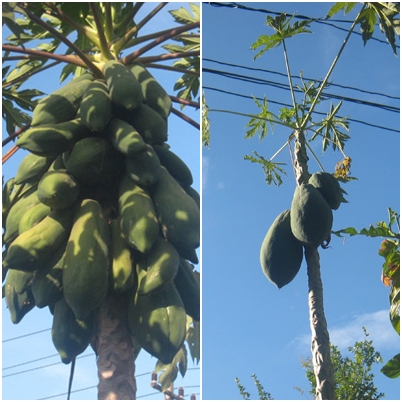
Yesterday’s blog post discussed various ways of boosting plant growth with liquid fertilizers. Well, a picture is worth a thousand words and so we took some photos of local papaya fruit trees to show what a difference proper fertilization can make. The EM fertilized papaya tree on the far left obviously received the nutrients it needed to be a prolific producer. I counted roughly 20 fruits. This papaya tree is in marginal soil and yet still prolific.
The second papaya tree was watered and fertilized regularly with cow manure, and yet you can clearly see it’s barely producing. Trees like this sometimes suddenly die and fall over. This is common in our area because of poor soil quality. Dig down next to plants, even those that are watered and fertilized regularly, and the soil looks like rammed earth or adobe. You can barely scratch the surface. One time I tore some cartilage on my rib cage trying to dig through this soil. Some areas look like the tamped road base in our earthbags. In short, the soil is dead and compacted. The ‘average’ amount of fertilizer, and leaves and straw mulch we apply are barely able to keep plants alive, even with frequent watering. So while our yard looks nice at first glance, most of the plants are struggling.
Here’s another video on fertilizing with EM. I was hesitant to use it because it advertises one brand of EM. We’re not pitching one brand, just suggesting that readers do their own research and consider trying it out. And like I explained yesterday, you only need a little bit to get started and then you can use it to make more in the future by innoculating and fermenting kitchen scraps (similar to making yogurt).
“Have you been looking for the best natural fertilizer for your plants? Recently my wife and I discovered a product that made our garden grow from tiny saplings to vegetables in just three weeks! and it’s totally safe and natural.
We’d like to share our experience with a product called EM, or Effective Microorganisms. This product has helped millions around the world grow bigger crops and gardens, improve soil conditions, and even clean up polluted water. My name is Chris, and my wife Nan and I have been using Effective Microorganisms for about 2 years. In our experience using EM in Thailand, we saw dramatic results like fruit trees giving four times as much fruit a year, and the fruit is sweeter and twice the size as normal! I’d be out in the garden and around the whole property spraying EM solution on ANYTHING green, and absolutely loved it, it felt like we were helping our property become more alive, and we could actually feel the energy around our house become more cohesive and supportive with the use of EM.
So what are effective microorganisms? EM is a naturally fermented live microbial product. EM is a safe alternative to synthetic chemicals that can be used for all plants, soils, cut flowers, fish ponds, composting, and deodorizing. It is completely non-toxic and safe for humans, animals, and the planet. What this means for us is healthier, in harmony soil, larger healthier plants, longer lasting flowers, clean green-free water features, and faster composting.”
Source: TeraGanix
Note: I checked Wikipedia for their take on EM. They are rather dismissive about the effectiveness of EM. The article states, “The Effective Microorganisms (EM) concept is considered controversial in some quarters and there is no scientific evidence to support all of its proponents’ claims.” Okay, maybe some of the claims are overhyped. That’s probably true with most products. But there’s no doubt that plant growth and productivity are improved. You can believe Wiki or just look around at your friends and neighbor’s plants. Maybe those millions of EM users over 25 years are wrong? Or maybe that Wiki entry was written by someone from the petrochemical industry?
I know what we’re going to do. We’re going to trust the local wisdom. Everyone here knows about EM. We’ve spent hundreds of hours trying to get our yard and garden in shape. A little bit extra effort to make and apply EM seems well worth the time. I’ll let you know how it goes.

Hi Owen,
We’re also in Thailand and have an independent farmer friend who uses EM on his vegetables and fruits. Question, is EM then considered organic fertilizer? Are there any ill effects on the consumer, such as allergic reactions,etc. ? Thanks!
EM is a supplement used in addition to regular fertilizer. There are no harmful materials. It’s all natural and probably an ancient practice. There are many different recipes. I suggest buying local brands or making your own because they’ll contain the organisms that naturally grow in your area. It’s pretty easy to find. I would not buy something from another country. Plus, you’ll save money.
We’ve already started two batches using rotting goop from our compost pile. I selected the slimiest material, not the stuff that was already totally decomposed. I added about 1/4 -1/3 bucket of goop in a 5-gallon bucket, 1 kilo of cane sugar, topped it off with water and stirred.
We also found low cost molasses for livestock use (non-food grade) and bought some EM to try out.